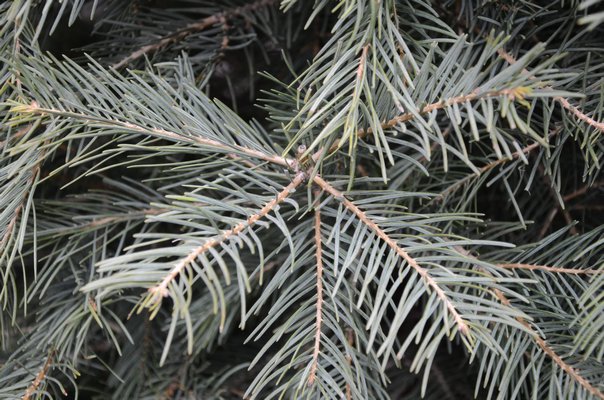

It’s time for Christmas tree shopping and, in spite of the blurbs on the news around Thanksgiving, there are plenty of trees to be had. But supplies are a bit tight, and the prices seem to be just a bit higher than last year. So here are some buying tips for just about every circumstance, budget and intention.
First, I hope you’ll follow my long standing tradition and plea of never, ever buying a fake tree. Buying a living tree—be it potted, balled and burlapped, or cut—supports farmers and growers instead of factories thousands of miles away. You can buy trees grown on Long Island that you can cut yourself or trees that come from upstate and Vermont. Please ask where the trees you’re shopping for come from and try to buy one that’s been grown as close to home as possible so you’re supporting local and regional agriculture. And by the way, big box trees are not grown locally.
If you’ve got young kids or if you just want the thrill of cutting your own tree, there are a number of nurseries on Long Island where you can cut your own. The nursery usually supplies a saw and will tie the tree and load it for you. Here’s link to a webpage that lists many of these tree farms and nurseries but give them a call before you drop in to make sure they’re open and hear what they’re offering: pickyourownchristmastree.org/NYxmasli.php. Again, call in advance.
If you’re tight on space, then a potted Alberta spruce can be perfect. These smaller spruces are hardy and can be planted outdoors, but if that’s your plan, then you’ll have to limit their indoor time. Plan on keeping an Alberta spruce indoors for no more than a couple of weeks and while inside keep it well watered as it’s a living plant that still needs water, holidays or not. You’ll find this spruce’s needles to be very fine in texture and the tree may have been sheered over the years to keep a nice tight shape. They’re slow growing and when planted outdoors they’re not fond of salt spray, so not great at the beach. You can find these from just a foot tall to 6 feet tall, but as a table-top tree a 6-footer may be a bit much. This is the perfect tree for an apartment or condo and some use them in outdoor pots decorated for the holidays.
You’ll also find Norfolk Island pines for sale. These are tropical plants though and can’t go outdoors. They’re not as dense as the spruces, firs and other traditional Christmas trees but they can double as houseplants after the holidays. They do get quite tall and don’t take well to pruning so give that some thought before you buy a 6-footer.
Balled and burlapped trees are another option. These can be firs, spruces and other evergreens that are dug in the field, the root ball tied with burlap and the tree is brought in for a couple of weeks at the holidays. It then goes outdoors for planting and becomes a permanent part of the landscape. These have been harder to find but not impossible if you ask at the larger local garden centers. If you choose one, you’ll need to dig its planting hole pretty soon so that when the holidays are over you can plant it. These still need to be watered, both indoors and out, and if kept indoors in a room that’s too warm they rarely survive when moved out again. Nonetheless, this can be a wonderful tradition and a great way to start your own Christmas tree forest on the back lot.
A more recent adaptation on the B&B tree is containerized Christmas trees. These are grown in nurseries in large pots and are a bit easier to move around than a B&B tree. The care is the same though, and you’re limited to having the tree indoors for only two weeks or so. You can also find some small specimens in 4- and 6-inch pots at some garden centers. These make nice decorations in the house, but again, they can’t stay indoors for more than a couple of weeks because they need to go out and get planted. Take care of them and in seven or eight years they can be your home grown cut Christmas tree.
And last, but by no means least, there are the cut trees. These are grown in nurseries from Georgia to Canada and shipped hither and yon to arrive at nurseries, garden centers and pop-up Christmas tree sellers on vacant lots, parking lots and in the city on some street corners. Most of these trees are cut in November so “fresh” is something of a misnomer. But as long as they have not been sitting in the sun or piled in a closed shipping container they should be fine. A quick and simple test you can do to see how “fresh” a tree is to run your hand down a branch and see if the needles stay on the tree or drop. Dropping needles is not a good sign. A similar test is to grab the tree by the trunk and lift it a foot or so off the ground and let the tree drop so the cut end hits the hard ground. Again, watch for needle drop.
Buy a tree slightly taller than your space will accommodate. This will allow for the 3 to 4 inches or so that will be sawn off the bottom of the tree to expose live trunk tissue that allows water to be soaked up by the tree to keep it hydrated when it’s indoors. Yes, even though cut, the tree will still soak up an amazing amount of water and this will not only freshen it up but it also reduces the chance of the tree drying and becoming a fire hazard. You’ll probably also want to prune off a few of the bottom branches so the trunk will fit into your tree stand. Don’t throw away the trimmings though. These make great table dressings and decorations.
You can store your tree in an unheated garage for as much as two weeks, but keeping it cool to cold is the key. Once indoors, start to water from the tree stand reservoir and keep that reservoir filled and check it daily.
After the holidays, we take our tree outside and I cut every single branch off using the branches as a winter mulch in various garden spots. Many towns and villages will collect them and chip them for mulch but why give it away when it can be used right at home?
You can find any number of needles evergreens being sold as Christmas trees including some pines, firs and balsams, but the most fragrant are going to be white and Scotch pines while the spruces have the best branching structure for hanging ornaments. For a combination of both structure and fragrance, consider the Douglas, Balsam and Fraser firs.
Have fun, shop around, avoid bargain trees and dropping needles, but most of all, keep growing.
 More Posts from Andrew Messinger
More Posts from Andrew Messinger